tracking pyongyang is a blog devoted to exploring the life, culture, society, and history of north korea through media. the aim is to offer those interested in the country a chance to view and hear it by facilitating access to content produced there, whether it is official state media broadcasts, international journalism, or clandestine video smuggled from underground. it also directs visitors to information published about the north from outside sources. some of this content is created and hosted here; most of it is not.
Don't wanna be here? Send us removal request.
Text
Nuclear Test, Videos, and Toys
North Korea's third underground nuclear weapons test is a familiar chapter in a narrative with no conceivable end in sight. As usual, even the country's closest allies have lined up to condemn the test as counterproductive to regional peace and security. But as long as China, which comprises roughly 70% of North Korea's foreign trade takes no tangible action, there will be no consequence serious enough to deter Pyongyang's leadership. The only substantial difference with this latest test is that it was suspected by many governments and observers to have involved highly enriched uranium. Unlike the limited stock of plutonium, this would give North Korea the ability to produce nuclear weapons well into the future. The highly enriched uranium would also make their nuclear exports a highly prized commodity on the international black market for weapons of mass destruction, and would facilitate their ability to covertly export them to the highest bidder. The other general fear here is that it will encourage other countries in the region to withdraw from the nuclear non-proliferation treaty (NPT) in a defensive bid to protect themselves. One Free Korea has a piece revealing some of the methods by which Pyongyang routinely circumvents the international sanctions designed to deter their pursuit of a nuclear arsenal.
While the potential uses of a North Korean nuclear weapon open a range of possibilities, Pyongyang's propagandists gladly filled in the blanks by releasing two surreal propaganda videos including one released by Uriminzokkiri in which a major American city is devastated by a nuclear missile to an instrumental version of "We Are The World" in what is depicted as the dream of a peacefully slumbering North Korean. The absurd fantasy of firing a nuclear warhead across the Pacific Ocean in a final bid of vengeance has proven too tempting to resist. Another, newer video shows Barack Obama and US troops in flames. In the gruesome context of DPRK propaganda, it is certainly nothing new. One distinction this time around is that both videos stole copyrighted material from major American video games, the first took explosions from Call of Duty and the second uses a looped segment from the theme song to Elder Scrolls: Oblivion, to the extent that YouTube eventually deleted both them after legal complaints from the publishers. The original source of these videos remains unknown but in this case points to younger pro-North sympathizers in South Korea, possibly in conjunction with propagandists inside North Korea. It doesn't stop at videos though, a number of primitive web games have surfaced allowing players to kill prominent officials from the U.S., Japan, and South Korea. The last few years has seen an internet media blitz by North Korea to modernize their propaganda and widen its audience. The vengeful productions that continually surface have blurred the lines between content produced by the regime and that made by its supporters abroad. Many South Koreans, whether or not they favor the North's policies, share its hostility toward the U.S. military presence in South Korea, and co-producing these videos with the regime's more fervent volunteers would be another example of the DPRK inciting Korean nationalism abroad to pursue the interests of its elite.
An interesting article over at News Focus International examines the decline of Pyongyang's standard of living relative to the rest of North Korea due to its distance from many black markets. Another piece there shows a recent trend among elite officials in Pyongyang to own a special refrigerator that holds the foods they're routinely given as bribes. There's also some good some pictures of North Korean toys.
12 notes
·
View notes
Text
Google CEO Visits North Korea with Former New Mexico Governor Bill Richardson
Former New Mexico Governor Bill Richardson and Google CEO Eric Schmidt recently concluded their "private humanitarian mission" to North Korea. While Richardson has long dealt with the North Koreans, especially when the State Department can't do anything (which is most of the time), what Google's CEO is doing there is a little less clear. North Korea not only lacks internet access, almost no one there even has a computer. On the domestic front, the trip's use as propaganda is not exactly obvious since most North Koreans don't even know what Google is. While Schmidt has long been an advocate of internet transparency and even hailed it as a way to topple dictators, any tangible influence his trip has on policy there will almost surely be zero. They were recorded visiting the Korea Computer Center in Pyongyang and certain locales in the country's standard showcase circuit like the Grand People's Study House. Technology was certainly the theme as they inspected North Korea's own Samjiyeon tablets (allegedly Chinese clones), and the regime's own brand of Linux. The North Korean "internet" is actually a large local intranet mainly used by students as a kind of reference database for research. Whenever Kim Jong Eun is shown at a computer with students, this is what's usually onscreen. There is actual internet with only about a thousand IP addresses registered, but it is confined to a very elite handful and visiting journalists. If it's true that the regime received Schmidt as a "rock star" like Richardson claims, the irony is palpable: Google Earth and its dedicated user base is more responsible than any other single party for exposing the true extent of North Korean's network of concentration camps.
Meanwhile, Korean American Kenneth Bae (배준호) remains imprisoned somewhere in North Korea, detained in Rajin on November 3 and charged with "hostile acts against the republic". This is a more plausible reason for Richardson to have made the trip, who is also a former U.S. ambassador to the U.N. and has acted as a de facto negotiator for the release of other Americans in North Korea. Bae operated a small tour group called "Nation Tours" which some speculate was a front for Christian missionary work. While North Korea's statement that he "confessed" holds no credibility in itself, the accusation that he was there to spread the gospel is not something to be ruled out, as it would not be the first such incident. Back in 2009, a Korean American Christian named Robert Park walked across the Chinese border into North Korea on Christmas Day with a bible and letters demanding Kim Jong Il step down and close his prison camps. Trespassing would be bad enough, but an ethnic Korean in North Korea calling himself American and even smashing a portrait of the Dear Leader was beyond blasphemous; the severe torture and sexual abuse he endured as a result has caused him to attempt suicide several times since his return to the U.S. He's since returned to Seoul to continue his activism. Then there's Aijalon Mahli Gomes, another American Christian who was arrested in 2010 after illegally entering the North as well. The regime claimed he tried to kill himself while detained. While a U.S. envoy failed to negotiate his release, Jimmy Carter successfully "bailed him out". This was the year after Bill Clinton had to do essentially the same thing for two American journalists detained for illegal entry while covering a story about human trafficking on the border. It is Richardson's private diplomacy and his high contacts in Pyongyang which have helped secure the release of at least most of these Americans from North Korea, beginning in 1996 with Evan Hunziker, who committed suicide shortly after his return to the U.S. While it's unclear whether that suicide was related to his detainment there, the crew of the U.S.S. Pueblo was tortured while they were detained for a year after the spy ship was captured by North Korea in 1968, and a number of them committed suicide after returning home. Suicide has been a disturbingly common trend here. But Richardson himself is indebted to the senior advisor who accompanied him, Tony Namkung, whose similarly close ties to the senior leadership combined with his experience spanning roughly 40 trips to the the DPRK played a vital role behind everything from Clinton's "rescue" to the retrieval of U.S soldiers' remains in 2008 and the opening of the AP bureau in Pyongyang. Eric Schmidt brought along Jared Cohen from Google Ideas, who has worked on applying technology to help solve problems in third world countries and co-wrote an article with Schmidt about how technology is redefining the relationship between states and their citizens. Well the objective of their trip may not be entirely apparent, their interest in the subject matter certainly is.
If the allegations of Bae's missionary activity are true, it is unclear whether he was operating alone. South Korean newspaper Kookmin Ilbo citing an unnamed source reporting that he was imprisoned after authorities confiscated a hard drive with "sensitive material" on it. Some speculate he was taking pictures of orphans and malnourished children. During tours, North Korean minders usually delete such pictures from your digital camera right away or confiscate your film. If taking photographs was the extent of his offense, it is even possible that the government detained him simply as a bargaining chip. Proselytizing is another matter; an offense for which North Koreans themselves can be publicly executed. Surely his actions were under more scrutiny than a tourist as the rare foreign owner of a business operating in North Korea. The "underground railroad" in China, which helps North Korean defectors gain safe passage to countries that will send them to South Korea, is largely operated by Christian missionaries and human rights activists from South Korea who in many ways see their missions to convert and rescue as one and the same. This is reflected well in the 2008 South Korean film Crossing about a North Korean who defects to China to find medicine for his wife, receiving the help of this clandestine network. In any event, Richardson delivered a written letter from Bae's son to authorities but was not allowed to visit him, left only with reassurances that his treatment has been fair and humane, and that judicial proceedings will occur soon.
17 notes
·
View notes
Text
North Korea Launches Satellite Into Orbit
On December 12th North Korea conducted its fourth satellite launch, it is their second attempt with the Unha-3 (은하3호) rocket; carrying a satellite called Kwangmyeongseong-3 Unit 2 (Morning Star 3 Unit 2, 광명성-3호 2호기) on its final stage, so named because Unit 1 was the one that failed a few months ago. It is their first successful satellite launch. There are a couple of relevant outcomes to this particular test: that the rocket's third stage was finally reached and that it actually succeeded in putting its payload into orbit. Despite being an impoverished nation devoid of democracy, North Korea is now only the tenth "space power" to have ever put an object into's Earth orbit. Of course the country has claimed that every launch except the failure in April succeeded in doing so. The state news agency KCNA has described Kwangmyeongseong-3 as an earth observation satellite that will gather meteorological data and help with agricultural development, making maps and surveying land. Roughly a week after the launch, U.S. officials are claiming that while it appears to be malfunctioning, it could remain in orbit for several years. KCNA claimed that the satellite would gather scientific data and, as always, broadcast hymns to Kim Il Sung and Kim Jong Il on the UHF band. While the test's ultimate function is to acquire knowledge about long range missile technology, this is at least close to a victory for the DPRK space program, since the satellite is currently in low earth orbit yet hasn't proven to be functioning in any capacity yet.
As in the past, the international response including from the UN Security Council has been almost universal in condemning the launch as a provocation threatening stability in the region, though you wouldn't know it from the KCNA mouthpiece. The single most consequential reaction will be from China to North Korea and may or may not become known in whole, as what is on paper is not the same as what happens on the ground. Though the nuclear issue serves the more tangible function of a deterrent, the 2010 attack on a South Korean submarine and the artillery bombardment of a South Korean island are not investments in defense but needless and bloody gambles, and illustrate just how far they are willing to go to make the mythical nightmare narrative into a very lethal reality. While the latest launch is being used to commemorate Kim Jong Il near the anniversary of his death, its practical significance is more connected with the nuclear deterrence. Their nuclear arsenal could not be a credible deterrent against the world without being able to pull off this kind of launch. Most of the world's governments with a few notable exceptions are predictably concerned about the direction into which these kinds of tests take the region, including an arms race and the technology's black market availability. But the tragedy of this nuclear crisis is not the international threat that hasn't materialized, it is the massive number of people who have already starved to death in order to make it happen. This program was alive in the 1990s and was in full gear at a time when starved corpses literally lay in streets and train stations.
14 notes
·
View notes
Text
Doubt On Camp 22 Closure, Agricultural Reform
Satellite imagery taken last Saturday and analyzed by the Committee for Human Rights in North Korea (HRNK) has revealed that contrary to earlier reports mentioned here, at least parts of Camp 22 appear to still be operating. While none of it is conclusive, the images in question show that mining and farming continue to occur there. Whether reports of its closure are partially or entirely untrue cannot be confirmed yet, just as the original report could never be verified in a truly dependable manner. The same uncertainty that shades most North Korean news also applies to reports that a deputy defense minster was recently executed with a mortar round for drinking and carousing during the official mourning period for Kim Jong Il. One who has learned enough about North Korea knows better than to dismiss even claims that outlandish, but it's enough for major papers like the Telegraph have even reported it as fact. Those executing him were apparently order to leave no trace of him behind, to his last hair. It's also been speculated that false reports of his death were purposely released to gauge the reaction of certain officers whose loyalty is in question. Originally the report from intelligence submitted to a South Korean politician. While the truth could never be known, it appears likely that he was at least executed earlier this year, along with a number of other senior officers who are still being eliminated in a broader and ongoing purge. If there there is any discernible pattern in the purges it's the possibility that Kim Jong Eun is shifting power from the military back to the party.
The June 28th Agriculture Policy has received a lot of attention since it was revealed months ago. This would allow farmers to keep 30% of their yield which would otherwise have gone to the government. It now turns out that this promise may not be binding when the yield isn't so good, and citizens are hearing it will be delayed. Cooperative farm cadres in Hyesan have allegedly told the farmers that feeding the military is enough of a priority to postpone the policy's implementation. Farmers can't conclude this is the case until the harvest finishes in December, but it is looking bleak. Though it's only a minor move toward agricultural reform it's still a step in the right direction at least. Of course the almost obligatory comparison is China, where workers on certain collective farms in the 1970s conspired and started producing astronomically higher yields that ended their starvation by simply allowing each other to tend and sell their own crops. This actually gave farmers incentive to work on their own farms, whereas in the Mao era they would have received the same meager amount even if they had worked day and night. The result lifted the living standards of hundreds of millions of people. Even when North Korea implements the reformed policy, the government will still keep 70% of what they produce, so truly meaningful reform is still as elusive as ever.
10 notes
·
View notes
Text
North Korean Concentration Camp Closes, Civilian Radio Stations Jammed
After first learning about the horrors inside Camp No. 22 in Hoeryeong (회령), North Korea near the Russian and Chinese borders, I had hoped its inevitable end would be under more liberating circumstances, but apparently the government decided to shut it down after its warden and a second official defected from the country in June. When we say "camp" here we are talking about 20,000 - 50,000 partially to fully starving people enclosed by electric fences and guard towers in the mountains with weekly executions and punishments like putting people in a box for a week. This particular camp has also had the infamous distinction of being used for human experimentation according to former officials from the camp who defected years ago. The large network of camps like this in North Korea are called kwanliso (관리소) in Korean or "political penal labor colonies". Misdemeanors are one thing, but serious crimes or insults to the Kim family or Juche ideology merit a complete omission of judicial process and the imprisonment of three generations of the prisoners' relatives in these special camps. Collective punishment of family members is one of the main incentives for all North Koreans to keep their mouths shut and tow the line. One of the many reasons people don't know more about these places is the same reason it took one of the only publications with sources inside North Korea, DailyNK, most of this year just to separate fact from rumor and confirm the news of its closure. While we can' know for sure why the camp has been closed, the fact that its prisoners are all being sent to other camps and the warden's defection would suggest it's out of fear of more defections in the camp's remote and precarious location close to two national borders. If one wants evidence of the Kim Jong Eun regime's comparative plans for human rights, they can note that since he took power the regime has greatly escalated its jamming of shortwave radio stations in South Korea that broadcast news into the North from the outside world and facts about human rights atrocities, damning lies endlessly spread as truth by the North Korean regime, defector stories, and so on. The civilian radio stations that make these human rights broadcasts are continuing to ask the South Korean government for permission to use stronger medium wave frequencies that cannot be easily jammed by North Korea. Unlike the technology otherwise ubiquitous to East Asia, analog shortwave radios are a very common form of media for North Koreans, and the one station all their radios are fixed to is Voice of Korea, formerly Radio Pyongyang, which still broadcasts "news" about the leader and ideology in eight languages including Arabic on shortwave frequencies every day. The fact that they broadcast it in Russian and Chinese does make sense, but I am convinced to this day that the only people listening to the Spanish shortwave broadcast of North Korean propaganda are radio hobbyists and Alejandro Cao de Benós, a Spaniard who moved to North Korea, wears a communist jumpsuit with a Kim Il Sung badge and calls himself North Korean.
17 notes
·
View notes
Text
Two Traitors and Their Tales
There have been two revealing articles published by the New York Times in the past week or so, both about outsiders to North Korea who through different circumstances became personally acquainted with the notoriously secretive Kim dynasty that rules North Korea. One is about Kenji Fujimoto, the pen name of a Japanese man who was Kim Jong-il's personal sushi chef from the late 1980s to 2001 when he escaped North Korea. He has been well known to all those studying North Korea since then for being one of the very few people to have known the Kims personally and lived to tell about it outside the country. Another remarkable aspect of his story has been his decision to write about his experience with them in detail, which culminated into three books published in Japanese with titles like Kim's Chef and The Honorable General Who Loved Nuclear Weapons and Girls. None of them have been translated into English so far. In these memoirs the Kim family is portrayed as one indulging in a nearly surreal amount of decadent hedonism. But for once the latest story about him adds a new chapter; after being so fearful of potential reprisals by the regime that he had reconstructive surgery, he received an invitation to the North in June by Kim Jong Eun. After some reluctance he finally went back, presumably taking the risk to see his family there. Kim forgave his betrayal, an impossibility under Kim Jong Il. Apparently enough has changed in Pyongyang to make some kind of an impression on him, and though his accounts of a modernizing living standard in Pyongyang are consistent with those of visiting journalists, he's careful not to make any conclusions about the rest of the country.
The other article is about Kim Young Hwan, a South Korean student activist whose virulent anti-Americanism and pro-North stance helped galvanize the underground activist movement which opposed the government of South Korean dictator Chun Doo Hwan in the 1980s. While the movement was unabashedly pro-democracy, Kim naively believed North Korean propaganda that claimed it was more democratic than the South, and he steered the movement in a pro-North direction, blaming American imperialism for the ills he and so many other South Koreans had suffered. Since the US had refused to intervene when Chun Doo Hwan ordered the South Korean military to slaughter students in the 1980 Gwangju massacre, the sentiment quickly echoed throughout the movement, and even today this stance is the status quo throughout much of the South Korean education system. He even joined North Korea's ruling Workers' Party. He eventually received an encrypted message from Radio Pyongyang to board a boat taking him North to meet the Great Leader in person. Ironically it was his personal meeting with Kim Il Sung which helped change him and his views completely. Apparently the aging supreme leader was no better at explaining the North's juche philosophy than anyone else was, and his mind was stuck firmly in memories of the 1930s anti-Japanese guerrilla struggle to liberate occupied Korea, a chapter of history that North Koreans hear about in their propaganda to no end. This revelation jolted him, and though he went so far as to accept money from the North to establish a political party for overthrowing the South, his eventual discovery of the rampant and egregious human rights abuses from those fleeing the 1990s mass famine there inspired him to actively change sides and become a vocal critic of North Korea. Ever the activist, he helped establish an underground network in China to help North Korean defectors evade the Chinese authorities who are all too happy to return them to the North. He was eventually caught and interrogated. In the Times article, I've found the memory of Kim Il Sung's rambling nostalgia to be the most revealing note, one of endless signs that the ideological integrity of North Korea is a complete mirage. It is no coincidence that the man who actually invented North Korea's cornerstone juche philosophy, Hwang Jang Yop, became its highest ranking defector and one of the most vocal opponents of the regime.
12 notes
·
View notes
Text
Keeping Out the Capitalist Contamination
When Willem van der Bijl, a Dutch tourist and entrepeneur who'd visited North Korea 24 times was arrested there on charges of espionage last year, it was certainly a surprise. Little did he realize that his detention would last a year and that his picture along with quotes praising North Korea's excellent election system would be published by the regime. Despite a lengthy relationship and a healthy business venture with the North, even he could not escape the perpetual paranoia of secret police. Incidents like his serve as a litmus test for just how open North Korea is to outsiders. The surveillance of foreigners in North Korea in one form or another seemingly has no exceptions; even Mr. van der Bijl's colleagues in the North were required to report everything they did with him. The fact that such ominous watching is even a feasible task gives one an accurate idea of just how few foreigners are in the country at any given time.
Reform in North Korea has always been a constant mirage to outside observers. Now that the Associated Press have a "bureau" in Pyongyang where mandatory guides kindly usher the journalists to places of interest, the speculation machine is even more rampant. Victor Cha brings this into perspective and his piece reminds one of what qualifies as real reform in North Korea; that is, the kind that hasn't yet come. While Kim Jong Il happened to be very elusive and more private with his own matters compared to his son, this made him an exception. If a dictator basking in the limelight and showing himself off were somehow always indications of a closest reformer, there would probably be far less autocracy today. The impression it gives off probably serves a more useful function for foreign policy than anything domestic. Average North Koreans are constantly mobilized for hard labor with 150 day "labor" battles that never net them anything of their own, it's a tactic that successfully exhausts them and occupies the time they could be spending earning private incomes in black markets. What's changed for journalists covering North Korea has not changed for them.
Meanwhile, all signs point to the old strategy of developing isolated "islands" of capitalism where a handful of selected North Koreans work alongside foreigners in business ventures funded mostly by China. These "special economic zones" like Rason and Hwanggeumpyong Island are meant to control the unwanted influence of capitalist, bourgeois, "anti-socialist" influences. Such locations really are necessary for any kind of private enterprise controlled by foreign investors to work because otherwise the social controls would prohibit most of their operation, for instance, the very sensitive matter of foreigners actually speaking to North Koreans. A great example is the Dutchman above. The latest indication that they're following this strategy would have to be Jang Song Thaek's 50 delegate trip to China. As long as the North pursues xenophobic policies to "purify" and isolate their society, attracting investment will always be a problem.
4 notes
·
View notes
Text
20 Year Ban On Women Riding Bicycles is Repealed
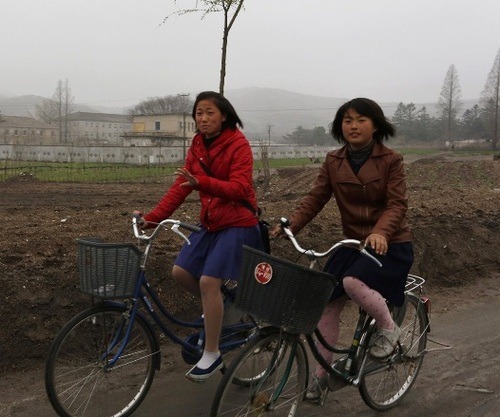
North Korea has just repealed a 20 year ban on women riding bicycles. While one might reasonably assume that this marks a historical first for the country, the ban is from the 1990s and seems to have been a result of Kim Jong Il hearing that the daughter of a powerful general was hit by a car in Pyongyang while riding one. The incident also brought about laws requiring registration and what are basically license plates. There was a fine imposed and confiscation for repeat offenses, though the above article mentions that bike lanes were also a result of the new laws. Etiquette was also a motive for the ban, as women riding bicycles was considered unbecoming. Bicycles are used in the countryside often enough that its enforcement in the provinces was relaxed by the next decade, as many photgraphs of the countryside can attest to. Daily NK also points out that most bicycles in North Korea are imported from China and Japan.
It's worth nothing that many of those that are made in North Korea are the result of forced penal labor. In a country where prviate ownership of cars is beyond the means of most North Koreans and highly restricted anyway, bicycles are valued significantly here. While cars are very gradually becoming more used for private enterprises, they are still well beyond the means of most North Koreans so bicycles remain by far the most common choice. Those with a significant commute or load to haul often depend on it with their lives. An accompanying ban on women wearing trousers often made it more difficult for those women who defied the ban; women are the only ones allowed to work in marketplaces, where their control of family income has slowly increased their influence in North Korean society. While the appearance of Kim Jong Eun's wife has lead many to predict a more "open" North Korea, it is of course only tangible action for common people that ever counts for anything. Though we don't who is responsible for repealing it, the ban extended to a national level and it's hard to imagine it being possible without the dearest supreme leader's consent.
22 notes
·
View notes
Text
Preparing For History
A North Korean living room, followed by a mock "North Korean" living room inside a South Korean museum:
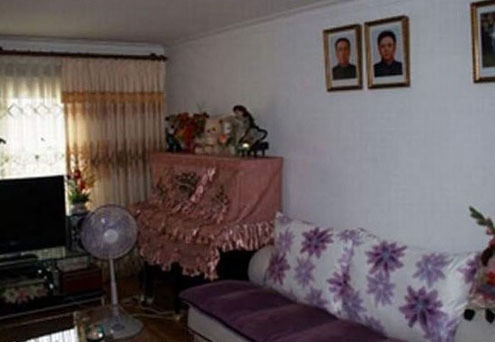
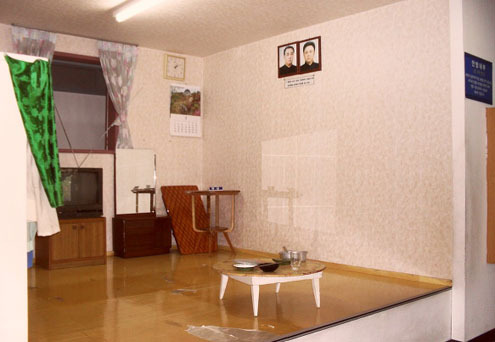
12 notes
·
View notes
Text
North Korea Burns Lee Myung Bak
On April 15th, Kim Jong Eun made his first public speech at the centenary parade for Kim Il Sung's birthday in Pyongyang. In the course of one minute he utterered more words in public than Kim Jong Il did during his entire reign of 17 years. This marks an approach much closer to his grandfather Kim Il Sung, who was clearly more comfortable with public appearances and who often made speeches lasting hours. Kim Jong Il was only presented in still slides and footage with voice over narration, and it many ways reflected just how little even North Koreans knew about the man they have to idolize every day.
One of the North Korean regime's trademark characteristics for quite some time has been its state news agency's penchant for what is, by almost all accounts, an incredibly inappropriate level of inflammatory rhetoric directed at the United States, South Korea, and Japan. The enormous amount of hyperbole found in its countless diatribes contributes to this tone of permanent hysteria in which it's often very hard to tell when any particular threat should be taken seriously. While the propaganda of Kim Jong Eun's era had seemed mostly indistinguishable from that of his father, a series of pieces aired over the last two months has amplified the rhetoric and made it more gruesomely personal. Kim Il Sung's centenary has marked a sensitive period for the regime's leadership, who has just completed a delicate transfer of power and is eager to prove its worth in the face of heightened promises and expectations to its populace. When South Korean president Lee Myung Bak suggested that $850 million would be better spent on food than nuclear weapons and other shockingly rational statements, the regime chose to take it as a personal insult to the "dignity of its supreme leadership." In reaction, state television has aired videos of regiments from the Korean People's Army threatening to kill the South Korean president, his defense minister, and one other official involved in the statements.
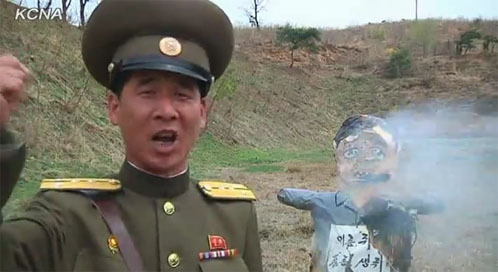
Soldiers in front of the camera continually refer to the president as vermin and describe their intent to dismember him and his officials personally. In one video, soldiers fire their guns at a target representing the president, then blow it away entirely with a rocket launcher for extra effect. This vendetta campaign hasn't been confined to the military though, during a recent rally at Kim Chaek University in Pyongyang, dummies were made of Lee Myung Bak and his two officials, dragged before a crowd of angry students chanting slogans, and set on fire.
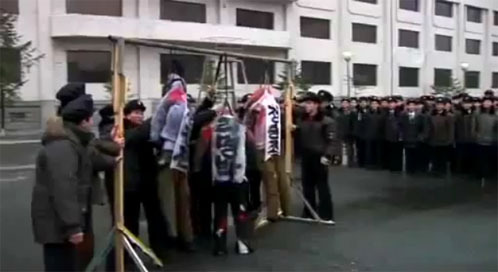
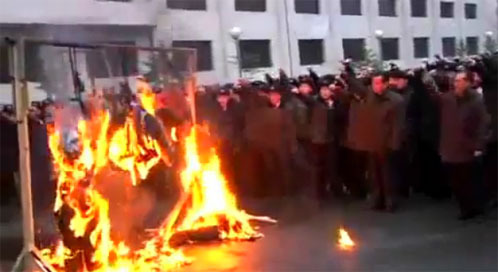
While the regime is eager to display its pride, prowess, or potency, it is usually less eager to show the outside world its more direct orgies of hatred, which are practically identical to hate week in the Orwell's 1984. Calling out such performances for having too much projection, however, doesn't quite account for context; the communal rage culminates in public executions where attendance tends to be mandatory, and Pyongyang is no exception. International pressure apparently curbed public executions roughly a decade ago, but it's always been there.
14 notes
·
View notes
Text
North Korean Rocket Crashes, Kim Jong Eun Promoted
On April 13th, mere hours after the Unha 3 rocket crashed into the Yellow Sea, North Korea held the fifth session of its rubber stamp parliament, the Supreme People's Assembly, at Mansudae Assembly Hall in Pyongyang. The timing of Kim Jong Il's death has seemed to have made Kim Il Sung's 100th birthday a naturally appropriate time to officially anoint his grandson Kim Jong Eun as successor to his father Kim Jong Il. When Kim Il Sung died, the regime had to make it clear that no successor could be a replacement, and so the dead leader was declared the republic's Eternal President while Kim Jong Il assumed a series of titles to establish his authority. In predictable fashion, the same has been done for the third Kim. While Kim Jong Il was General Secretary of the Worker's Party of Korea, that title has now been retired, and Kim Jong Eun has been promoted to the previously nonexistent post of First Secretary. This is also the case for his other promotions, just as his father was Chairman of the National Defense Commission, Kim Jong Eun is now First Chairman, and accordingly, his dead father is now Eternal Chairman.
The real surprise here is not what's similar to the last rocket tests but what's different; while the launch failed just as clearly as previous ones, the government has taken the unprecedented step of admitting its failure. There was a time when North Korea would not have even thought twice about lying to its own people. But with over a million cell phones now in the country, a more porous border with China and the stampede of foreign journalists invited to attend, they seem to have concluded that losing face is preferable to being caught in a lie by their own populace. After all, technical difficulties are far less damning than deliberate acts of deception. Still, one should obviously not take this to mean that they wouldn't have lied had they thought there was a guaranteed opportunity to do so. Although foreign journalists had been allowed to congregate and snap pictures of the rocket waiting on its launch pad, they were not allowed to be there for the actual launch, hence the lack of footage. Given that the rocket failed apparently 81 seconds after liftoff, it's not hard to see why. Really the only other time this regime has actually admitted that it failed was in the wake of its disastrous currency confiscation in 2009, ostensibly an attempt to eradicate private markets and individual's personal savings. But in the wake of international condemnation for the launch, a Chinese firm has been caught violating U.N. sanctions by supplying technology to North Korea to help construct their launch facility. China's government denies any wrong doing in the matter. In the weeks since the launch, many are predicting North Korea will conduct a new nuclear test within the next few months to save face and reinforce the threat. This would certainly fit its past patterns of provocation.
There are now over 20,000 North Korean defectors in South Korea, but only a small number of these are people who've managed to escape North Korea's extensive network of concentration camps. Yet Shin Dong Hyuk is an even rarer breed in that he was the only one to escape what are called total control zones. Since they are designated for political criminals who are judged irredeemable and given life sentences, these special camps are literally the only places in North Korea where propaganda about the Kim family is totally absent. Shin was actually born inside of Camp 14, so he had never heard of Kim Il Sung or Kim Jong Il. In a place where sex between prisoners brings an immediate death penalty, he was the product of two inmates given five hours together as a reward for his father's good behavior doing mechanical work in the camp. Shin was on the brink of starvation from birth, and he had to watch his mother and brother be publicly executed. Only after an outsider broke rules and told him about the abundant food outside of the camp did he consider escaping. Eventually he managed just that, and in comparison, North Korean society seemed quite free to him. Despite being located closer to the DMZ than the Chinese border, Shin managed to escape the country, then make his way from China to South Korea. He's been telling his story for years to those who will listen, but now journalist Blaine Harden has written a book called Escape From Camp 14 based on his extensive interviews with Shin.
3 notes
·
View notes
Text
Film Director Shin Sang Ok, the Most Famous South Korean Kidnapped by Kim Jong Il
Shin Sang Ok (신상옥) was a legendary South Korean film director in the 1950s and 1960s. Both he and his wife, star actress Choi Eun Hee (최은희), were household names in that era. Always very prolific, he directed over 70 films throughout his life, the "Orson Welles" of South Korea for those who love arbitrary comparisons. He helped progress cinema to new creative heights, and revealed his hallmark independence by refusing to follow orders from the various dictatorships of South Korea, who eventually revoked his license. But a scandal in 1976 resulted in a much publicized divorce from Choi, and his trials would eventually get much worse.
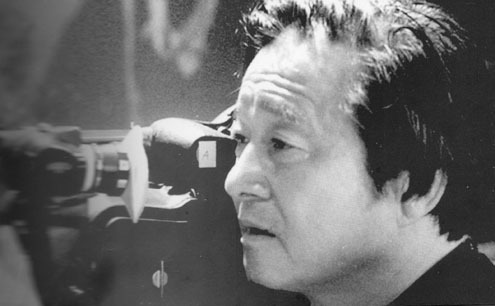
Later that year, Choi was kidnapped in Hong Kong by North Korean agents, and when he went to look for her, they kidnapped him too. Shin would soon find his fate controlled by the whim of Kim Jong Il, who had kidnapped Shin and Choi for the express purpose of forcing them to make films to improve the international image of the Worker's Party of Korea. While Shin's initial accommodations were comfortable, he soon tried to escape, and was imprisoned for five years where he had to eat grass and hear propaganda daily. One day he and his wife, whose whereabouts had been totally unknown to him, were suddenly released and summoned by Kim, who then told him that North Korean's cinematic standards were low, and that Shin could make any film he wanted.
Kim Jong Il gave him more creative room than any North Korean director; when Shin needed a train to explode, Kim immediately gave him one to detonate. While he obviously didn't have total creative freedom, Kim never forced Shin to make idolatry films. Obsessed with cinema, Kim simply wanted better North Korean films. Quite unsurprisingly, Shin never actually believed in any of the propaganda, he was well aware that pure obedience was only the possible route for survival. He would direct films in North Korea for the next three years. The most famous production of his North Korean period was essentially a Godzilla set in feudal Korea with special effects help from Japan called Pulgasari (불가사리). But Shin's favorite work was the first one he directed there called Runaway, about a Korean family in 1920s Manchuria, surviving oppression by the Japanese. Such was the very unexpected revival of his career, now worth three million dollars a year, and connection to North Korea's Dear Leader. Once, Kim was throwing a birthday party for one of his generals, and Shin was present. During an adoring performance of young women wishing him long life, Kim even leaned over to Shin and told him it was all pretense.
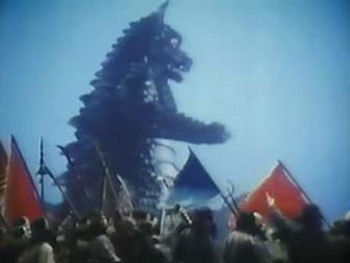
After three years and seven films, he and Choi, by then remarried, had developed enough trust from Kim Jong Il, and once when they went to speak with him, Choi bought a small tape recorder beforehand in a Pyongyang Department Store, and made a recording of their conversation with Kim Jong Il lasting over forty minutes. Other than a small snippet of footage from a 1992 military rally and brief audio from the two inter-Korean summits, this is the only known recording of Kim Jong Il's voice outside of North Korea. They had risked their lives to tape the conversation as proof that they had been abducted. This was presumably more to placate the government of South Korea, which was still under a dictatorship and may have punished Shin had he chosen to return there. He and Choi were eventually permitted to travel on business to Vienna. While there, they managed to escape their minders with the help of a Japanese film critic and sought asylum in a U.S. embassy. He would restart his career in the U.S., and ended up writing and directing some of the 3 Ninjas movies. He eventually returned to South Korea in 1994 and continued working on films there until his death in 2006.
Shin has said that if his life were ever a film, no one would believe it, and I am inclined to agree. Accordingly, his autobiography is entitled "I Was A Film". He is survived by Choi, who helped published it. They had been remarried at Kim's recommendation, and it's fairly safe to say that would not have happened were it not for that eight year sojourn in the North.
44 notes
·
View notes
Text
North Korea to Launch Third Space Satellite for Kim Il Sung Centenary
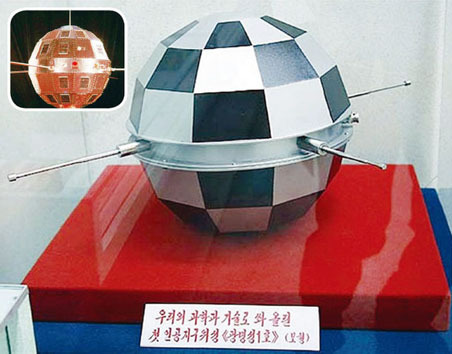
Just weeks after completing negotiatons with the United States for food aid in return for halting uranium enrichment, nulcear tests, and missile tests among other programs, the DPRK has announced it will test what will now be its third satelllite under the name Kwangmyongsong (광명성), which means “guiding light” or Lode Star, in Korean. In North Korean propaganda, there are banners all across the country that read “Long Live General Kim Jong Il, Lode Star of the 21st Century”. The launch of Kwangmyongsong-3 is being perceived as a provocative act by nearly every nation even including China, which is by far North Korea's closest benefactor and ally, because it is allegedly being conducted by launching long range multi-stage rockets that directly violate both U.N. resolutions to which it’s obligated and, in this case, to the deal it made with the U.S. weeks ago. It’s not the purported satellite that concerns other nations, but the Unha (은하) rocket that will supposedly carry it to space. Internationally, North Korea contends that it is entirely for peaceful use by emphasizing the fact that the missile tests are also meant to celebrate the 100th Day of the Sun, Kim Il-sung's birthday, on April 15th. In state media it is being hailed as an achievement in space technology and a national milestone. But just last January a one hour documentary about Kim Jong Eun on KCNA attributed past nuclear tests to his own military genius. One might doubt that a country boasting about its prowess through the language of nuclear weaponry will be sincere about disarmament months later, but the U.S decided to follow through with a plan made while Kim Jong Il was alive that agrees to abandoing uranium enichment, nuclear tests, and more in return for food aid. Now that Kwangmyongsong-3 is being launched, the U.S. has described North Korea’s act as highly provocative; the U.S. State Department said it makes food aid "hard to imagine", and the Defense Department claimed it would destabilize the region. Much of the international opposition is out of a mutual desire to avoid an arms race in East Asia.
A chorus of international opposition has been joined by U.N. Secretary General Ban Ki Moon, a South Korean national, who has urged North Korea to not to proceed. North Korea claims it has a sovereign right to test space technology, but the agreements to which it’s signed on have made clear that such a launch is not acceptable without violating the terms. The overwhelming consensus internationally is that the tests have been primarily to help develop the military technology necessary to launch intercontinental ballistic missiles. This would give their nuclear deterrence more meaning in general once it’s been confirmed that they are capable of hitting targets as far away as the U.S. It also makes the country a more attractive black market option for nations like Iran, which along with Syria has been a past customer of the North’s nuclear technology. North Korea’s government has informed the relevant international agencies that the rocket’s trajectory will take it over both Japan and Taiwan, before being expected to land in waters some 80 miles off South Korea’s coast. According to KCNA, Kwangmyongsong-3 is a "polar-orbiting earth observation satellite" that will be launched southward from Cholsan County in North Pyongan Province, which is on North Korea's west coast. Japan has already publicly stated the possibility that they will shoot it down should it come within the nation’s airspace. This all comes as President Obama is set to visit Korea’s demilitarized zone (DMZ) on Sunday as part of his trip to the global nuclear security summit in South Korea.
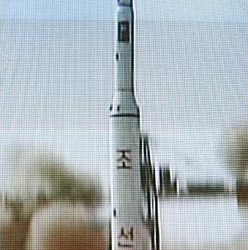
The first and second Kwangmyongsong satellites, launched in 1998 and 2009 respectively, were both heralded by North Korea as successful tests of its space technology. But in fact, no other nation on Earth was able to detect that anything had actually entered orbit. Undeterred, state media described both launches as resounding triumphs, insisting that the first satellite had broadcast “The Song of General Kim Il Sung” and “The Song of General Kim Jong Il” after reaching space. Kwangmyongsong-1 was launched just as Kim Jong Il officially inherited the rule he had established right after Kim Il Sung’s death in 1994, and was launched at a time when tensions in the region were lower and nations had more immediate hopes of denuclearization in Asia. In fact the People’s Republic of China helped develop the satellite, just as when they launched Dong Far Hong I in 1970 under Mao and broadcast “The East is Red” when it successfully entered orbit, and that one did actually enter orbit. But while China aims at a manned lunar mission by 2020, North Korea still cannot feed its own population. The idea that space technology is of any immediate interest to a nation with such priorities is hard to swallow without the caveat that it’s for launch technology that will make its already existent WMDs deployable to a much bigger selection.
Kwangmyongsong-2 was launched just three years ago in a different international atmosphere. This time around the concern’s been graver and more overt after North Korea's artillery bombardment of a South Korean island, its sinking of a South Korean submarine, major U.S. wars abroad, “axis of evil” reaction, multiple underground nuclear tests, a secret uranium enrichment program North Korea lied about for many years even while at the Six Party disarmanent talks, and a bevy of other factors. There’s been reluctance to antagonize the North at the moment in order to better understand how or if a regime under Kim Jong Eun would behave any differently, but the latest launch makes that more clear. Kim Jong Il relied less on the party for supremacy than his father and started an era of “military first” politics both to prevent a coup and to create a siege mentality that sacrifices for the military would be necessary for all North Koreans’ survival against imperialist aggression from the U.S. Kim Jong Eun seems destined to continue that policy for the time being. Anyone who understands the true grip of this personality cult on North Korean society would also understand why this country did not collapse after Kim Jong Il’s death. But tension is high now, with China receiving unusually publicized but always vocal criticism for its latest repatriation of North Korean refugees to what will certainly be punishments of torture and possible death back home. This even lead to a recent scuffle between North Korean and South Korean diplomats at a U.N. human rights meeting. China has just installed silent alarms in the houses of border towns for its crackdown on North Korean escapees, just as U.S. lawmakers are set to renew North Korean human rights legislation, which does everything from funding opposition radio broadcast into North Korea, to offering resettlement opportunities in the U.S.
North Korea’s not the only one celebrating Kim Il Sung’s 100th birthday, there’s also a photographic exhibition of the Great Leader in New York, brought to you in part by the Associated Press. Meanwhile, the official website for the Korean Central News Agency declares on its front page "anyone hurting the dignity of the DPRK supreme leadership will find no breathing spell in this land or sky". The owner of the gallery where the exhibition's being hosted is on the Board of Directors for Human Rights Watch. Go figure.
15 notes
·
View notes
Text
Chongryon: The Japanese "North Koreans"
When observing a place like North Korea, you're often exposed to a way of life that many correctly assume would never be possible in an open society, or anywhere outside the country. While that's usually accurate, it also begs the question of how over 150,000 Koreans in Japan openly express their loyalty to North Korea and the Kim family. They account for about a quarter of Japanese Koreans and have been present there since before Korea was divided. They are a testament to the power of families to indoctrinate even in a society that's incompatible with their teachings. These Koreans are unified under an organization called Chongryon (총련) or the General Association of Korean Residents in Japan (재일본 조선인 총련합회). Since North Korea has no diplomatic ties to Japan, it has served as the de facto embassy there. The majority of Japanese Koreans hold South Korean citizenship through a far more innocuous organization called Mindan (민단) or the Korean Residents Union in Japan (재일본대한민국민단) which for reasons that may soon be clear, is not quite as controversial. Unlike Mindan, Chongryon's quasi-official status makes it a more direct representative of its nation, and the leaders of Chongryon are actually members of North Korea's parliament. Their meetings in Japan appear like something straight out of Pyongyang.
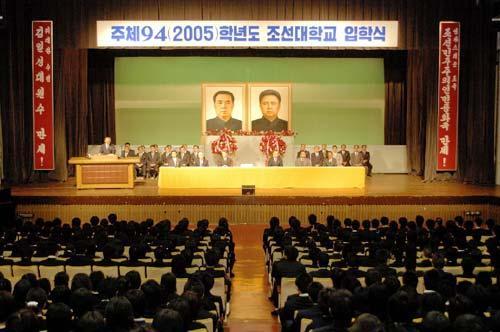
Japan colonized Korea for 35 years, and the last years of this occupation were the most extreme, when Japan attempted to erase the Korean language, culture, and identity. In a bid to make a better a life for themselves and their families, thousands of Koreans moved to the Japanese mainland, learned the language, and settled there as immigrants. While some became Japanese citizens, most chose to live there as permanent residents. After Japan surrendered in WWII and Korea was divided, they were free apply for citizenship back home, but which Korea?
Short of manpower and foreign currency, North Korea established the "Return Project" in 1959 to repatriate Japanese Koreans by luring them with promises of "Paradise on Earth". During this time, massive foreign aid from the Soviet Union allowed the North Korean economy to briefly surpass that of the South; a rare period when the North could back its rhetoric with superior numbers. Over 90,000 would heed the call to return over the next 20 years. But what these immigrants were expecting is not what they ended up experiencing, and like all other North Koreans, they were never permitted to leave once they arrived. They had anticipated that either Korea would soon be reunified or that North Korea would at least establish diplomatic relations with Japan, neither of which has happened to this day.
Sometimes entire families emigrated back to North Korea, while other times they sent their children to live there. In a documentary called Dear Pyongyang, a Japanese Korean documents her elderly father, who was a leading member of Chongryon and sent all three of his sons to live in North Korea. He has had to grapple with that decision for decades now, but him and his ardent communist wife still believe in the cause. Other cases are more blatantly tragic, a more infamous example being that of Kang Chol Hwan, who was just a boy when he and his entire family moved to Pyongyang in the 1960s. He and his family were never fully accepted in North Korea due to their time in Japan, and after his family kept losing one possession after another to the party, his father was eventually accused of being a counter-revolutionary. After a knock on the door at night, the entire family was trucked off to a concentration camp where he survived for ten years and was eventually released before escaping to South Korea via China and becoming a journalist in Seoul. The memoir The Aquariums of Pyongyang describes his ten years in the gulag and is a veritable horror story of beatings, torture, executions, starvation, and relentless propaganda. He was one of the few to make it out of both the camp and the country alive. North Korea denies the camps exist.
Not only do the Japanese Koreans of Chongryon adhere to North Korean ideology, they are also known in Japan and elsewhere for their exclusive and isolated education system. While the children of these families grow up next door to their Japanese counterparts, they only attend special schools run by Chongryon. In fact, the organization operates 140 schools from kindergartens to a university. In many ways, the schools are a microcosm of North Korea, complete with portraits of the Kims hanging in every classroom, and the main language of instruction being Korean. Their textbooks have also courted controversy, insisting that the North's 1987 bombing of a Korean Air flight never happened and is a fabrication. This is in contrast to the memoir of the spy who planted the explosives. Sometimes the schools organize field trips to Pyongyang, complete with as much propaganda as any Western visitor would ever receive.
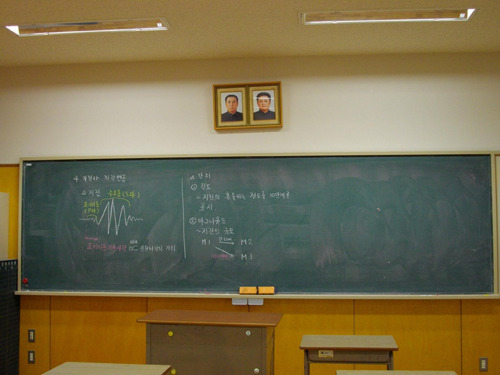
Many of the elder Chongryon members are aging ideologues nostalgic for the brief period when North Korea's economy was stronger than that of the South. But it's more of a conundrum to figure out how the younger members can grow up in a globalized, consumer society and yet maintain their loyalty to an impoverished totalitarian nation that many of them have never been to. Some maintain their adherence, but evidence is showing that third and fourth generation Chongryon members are dissatisfied and being more assimilated into Japanese society. Yet their roots in the organization have been the source of an increasing social problem for them because no one who graduates from these schools is eligible for the college entrance exams. Already a minority in Japan, it makes their prospects in the competitive job market there that much more bleak. The few schools run by Mindan and other foreign schools are eligible, but many of these also teach in Japanese and are more integrated. A short documentary featuring interviews with younger Chogryon members can be found here.
Financially, the relationship between Chongryon and North Korea is an important two way street. The Japanese have a game called pachinko, which can be described as a cross between a pinball and a slot machine. It's the only form of gambling nominally tolerated by the government there, and it's usually played inside loud fluorescent parlors with narrow rows of seats often fully occupied. While some of these are by the Japanese mafia, anywhere from 30-80% are operated by Chongryon. Much of the revenue goes back to Pyongyang along with remittances, and in 2005 alone the total exceeded $120 million. Some of Chongryon's education system is occasionally funded in part by Japanese taxpayers, and in part by North Korea. There used to be over 160 schools, but many have shut down due to decreasing funds; there's even footage of an abandoned one here. Until a few years ago, Chongryon's semi-official status gave it diplomatic immunity from legal action, but not so anymore. It has been in the spotlight for not repaying its loans, as well as various other charges from embezzlement to unlicensed accounting and tax evasion. A Japanese Marxist governor exempted Chongryon from taxes in 1972, but this was revoked in 2003.
Though South Korea is a liberal democracy, its National Security Law presents an exception to freedom of speech by archaically banning any material regarded as pro-North Korea. As such, no organization even remotely like Chongryon would be permitted to exist there. North Korea allows Chongryon families in Japan to visit their relatives living in the country on a somewhat regular basis. They often smuggle in remittances and bring gifts. All of the travel is on board a passenger ferry called the Mangyongbong-92 (만경봉 92호), built in 1992 to commemorate Kim Il Sung's 80th birthday. It travels from Niigata, Japan to Wonsan, North Korea on trips roughly a day long about 20-30 times a year. The ship was banned from Japanese ports for six months in 2006 following allegations that North Korean spies had been trawling Tokyo's megamalls for everything from Playstations to camera lenses with the sole purpose of expropriating the technology for its military hardware. It's been the target of numerous accusations and rumors of smuggling including methamphetamines. Nowadays it is also being used as a tourist cruise ship that travels between domestic ports in North Korea.
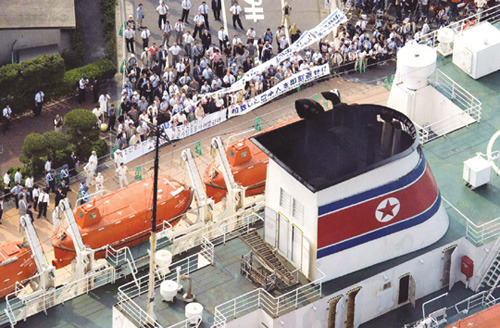
Chongryon was largely responsible for North Korea's representation on the internet for quite some time, and still maintains a large portion of it through propaganda websites republishing articles from the Workers Party's official organs. There are also some North Korean websites hosted in China, though many are actually based in North Korea now as well. It's worth nothing that due to the law mentioned above, all of these sites are banned in South Korea, when trying to access them you instead get a government warning, and unless one knows how to connect through a proxy server that's the case with most of these websites, certainly the ones hosted in North Korea itself. While South Korea has the greatest ratio of internet users in the world, almost no one in North Korea has a computer, and even if they did the internet is out of the question. In fact, one village in particular has been without electricity for seven years. The target audience for these websites has not always been clear, but North Korea's propaganda wing has still made efforts to expand to Facebook, Twitter, and Youtube in recent times as well. Apparently for quite some time the North Korean government's Facebook profile said it was interested in men.
14 notes
·
View notes
Photo
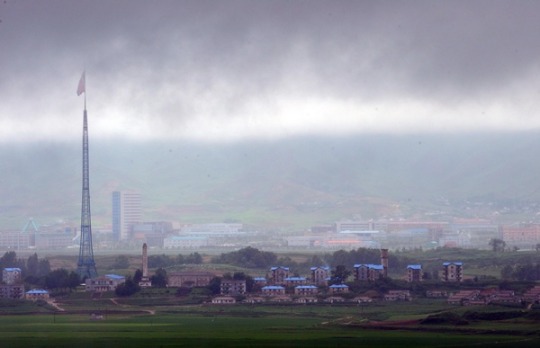
Determined to quell the notion that its citizens live in anything less than a worker's paradise, one of North Korea's more infamous contributions to the de-militarized zone (DMZ) includes a propaganda "village" of around 200 people that almost all outside observers agree is entirely fake with no actual inhabitants. While North Korea officially insists that Kijongdong (기정동) is a collective farm of 200 families with schools and healthcare centers, this does not appear to stand up to scrutiny. Any quick telescopic viewing reveals empty buildings without glass windows or even interior rooms. The sidewalks are empty, and all of the village's lights turn off and on at set times. Occasionally a crew comes to maintain the area. While the North Koreans sometimes refer to it as "Peace Village" (평화촌), the South Korean media have dubbed it the "Propaganda Village" (선전마을). A modern incarnation of the Potemkin village phenomenon, the village was built in the 1950s to encourage defection from South Koreans, and after the Korean War it was one of only two settlements allowed to remain in the heavily fortified DMZ that now divides the Korean peninsula. When it was built, the brand new buildings, freshly painted and apparently wired for electricity, would have been a luxury for any Korean. It's the only North Korean "settlement" visible from the DMZ itself, but no tourist in North Korea has ever been allowed to visit. It's also called Propaganda Village because of the virulent anti-Western propaganda blared over loudspeakers 20 hours a day near the village, though this is done in different parts of the DMZ. The broadcasts stopped in 2004 after a thaw in inter-Korean relations, but resumed in 2010 after North Korea torpedoed and sank a South Korean submarine, killing 46 soldiers.
It's also home to what was once the world's second tallest flagpole, raised in response to a South Korean flag nearby. This eventually started a "flagpole war" during the 1980s in which the North eventually proved it cares a lot more by building one so tall that at 525 feet, it needs its own outside structure just to support it from falling.
35 notes
·
View notes
Photo
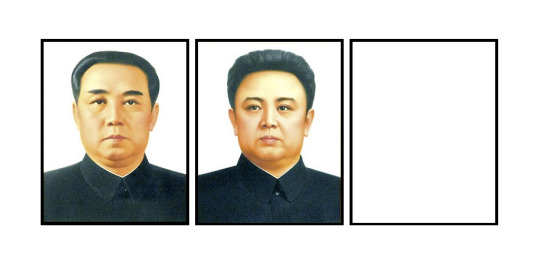
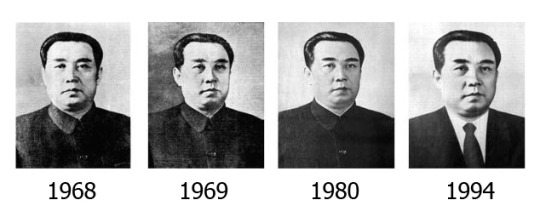
According to some sources inside the country, the first portraits of Kim Jong Eun are now being hung. These ubiquitous portraits of the Kim family may be the most potent and universal symbol of the regime's idolization. North Korea has taken this practice to an unprecedented extreme. Not only is every private household in the country required to display portraits of Kim Il Sung and Kim Jong Il, the residents are also required to adequately care for them. One is not even allowed to put pictures of anyone else on their own wall, whether friends or blood relatives. There are very real punishments for those who neglect the portraits or fail to put them on display. Such offenses are not petty crimes but political heresy that violate the Ten Principles and have severe consequences; a life in the prison camps is not of the question if you're found to be unrepentant. The Public Standards Police are to visit homes on a monthly basis to inspect the portraits. North Korean newspapers have even run stories about heroic citizens sacrificing their lives to save the portraits from fires and floods. They are also found in just about every public building in the country from classrooms to the airport. Even the subway train in Pyongyang has them on board.
Just as with other propaganda of central importance like statues and monuments, the sacred visages are rendered at the Mansudae Art Studio (만수대창작사) in Pyongyang. They're then reproduced and even distributed along with a cloth to clean them that may only be used for the portraits. In almost every case it is the same two painted portraits depicting both without their glasses and stoic faces, though a select few have a similar set of head portraits but with three including one of Kim Jong Suk, Kim Il Sung's first wife and the mother of Kim Jong Il, beaming in military uniforms. There's some variations, sometimes the third pictures features both Kims. The first Kim Jong Eun portraits are reportedly being hung in Pyongyang's revolutionary museums by the National Security Agency, a notorious state organ through which he rose in rank before the succession. In 1974, the NSA also put up the first Kim Jong Il portraits, though it wasn't until around 1980 when he was officially announced as successor at the sixth Worker's Party congress that they were distributed to homes. Above you can also see the subtle evolution of Kim Il Sung's portrait, more notable for what doesn't change than what does. In the last one you can see he's in a Western business suit, for which he permanently replaced his classic communist jumpsuit in 1984.
If there's any propaganda to rival the ubiquitous portraits, it would have to be the equally omnipresent badges of Kim Il Sung that every North Korean must wear across their left breast. These were first distributed in 1972 to commemorate Kim Il Sung's 60th birthday, and wearing them soon became a requirement. The Maintenance of Social Order brigade is responsible for enforcing this rule, and those who violate it would have to attend extra ideological sessions. Some editions feature both Kims. But now there's a badge for Kim Jong Il too, and the first ones have just started appearing. Though quite a few Kim Jong Il badges seem to have appeared on eBay in the past, they've never been worn by North Koreans, and these ones appear to be a new edition meant for that. Scratching or getting red ink on the badges is regarded as defacing the revered iconography, and at least one man tried to commit suicide when he discovered he'd scratched his badge.
27 notes
·
View notes
Photo


After 23 years of stalled development, the Ryugyong Hotel (류경호텔) is finally set to open. What started as an ambitious project to build the world’s tallest hotel soon became a logistical disaster that came to symbolize the country’s economic woes. The giant pyramid with 3000 rooms is Pyongyang’s tallest structure in a sea of already colossal buildings, and at 1,082 feet and 105 stories, it dwarves everything else in the city. It is set to open on April 15, 2012, the 100th anniversary of Kim Il Sung’s birthday.
The hotel’s origins date back to 1986, the year that South Korean conglomerate SsangYong finished constructing the Westin Stamford Hotel in Singapore, which was then the tallest hotel in the world. In what's reminiscent of their desire to have the world's tallest flagpole, North Korea was not to be outdone. Construction began in 1987, but the rivalry would intensify politically. South Korea was attracting massive investment and interest in preparation for the 1988 Olympics in Seoul, and was making new additions to its skyline including stadiums and hotels. This prompted a strong reaction from the North, and it’s still widely believed that they bombed Korean Air Flight 858 to dissaude athletes from traveling to the games. But much of their response was a more constructive effort to rival the games by hosting the 13th World Festival of Youth and Students in 1989, which is basically the communist Olympics. The Ryugyong was set to open for the festival, for which other massive Pyongyang landmarks were also built, like the Ryongrado May Day Stadium that hosts the Mass Games every year. There’s actually video of the festival available online that was uploaded by tourists there at the time, and it’s a rare chance for outsiders to see footage of Pyongyang in the eighties (you certainly do not see anything like this in Pyongyang every day, or month, or year).
Planning and doing are very different, however. A lack of materials and funds quickly halted the project, and the fall of the Soviet Union played no small part. Once the building reached its full height in 1992, the construction was halted after estimated costs that were equivalent to 2% of the country’s GDP. As the country entered a massive famine, completion was delayed indefinitely. The building’s hollow concrete edifice then towered over the Pyongyang skyline completely untouched for another 16 years. Throughout most of this period a crane even sat at the top, as if construction was always about to be resumed.
The thwarted project was not even officially acknowledged by the government. In the propaganda from stamps and other sources, some pictures of the hotel were doctored to make it look occupied, while others removed it entirely. It was also removed from maps, and guides who were asked about it typically gave no response. Much of that time was probably spent waiting for foreign investment, because that’s ultimately what’s allowed the building to be completed. Though they had tried to court foreign investors from the beginning, this fell through, and it wasn’t until Egyptian company Orascom Group was contracted out that anything significant started happening. Orascom is more notable for investing in North Korea’s cellular industry by establishing the first 3G network there, which at this point is estimated to have over a million subscribers. Many have speculated that they agreed to finish the Ryugyong as a condition for the opportunity to launch the country’s mobile sector, but for their part they have insisted this is not the case. In any event, Orascom resumed construction of the hotel in April 2008. Brief footage from 2011 of what it looks like now can be found here.
A few practical observations are in order here to give some context. The tourism industry in North Korea is incredibly small. Pyongyang boasts a number of other large hotels to rival the scale of any four star establishment. No matter what time of the year it is, all of these hotels are nearly empty. If their operation were ever reliant on revenue, they could never exist. Not nearly enough people come. But they are clearly built with the pretense that this either isn’t the case or that it won’t be very, very soon. In this state of affairs, many would not imagine that spending over 750 million dollars on a hotel with five revolving restaurants is in order, but Kim Jong Il would insist otherwise. After the contribution by Orascom, the total cost will almost certainly exceed a billion dollars. Not even the North Koreans are expecting to fill it to capacity by tourism alone, and Orascom has stated that it will have mixed use including offices.
But Egyptians are not the only foreign investors in North Korea, and neither are the Chinese. Until a few years ago, the Trading With The Enemy Act (TWEA) barred American companies from doing business with North Korea directly, but no longer. A liquor importer from New York called Korea Pyongyang Trading USA has been hired to help revive North Korea’s resort in Mount Geumgang (금강산). The luxury resort, featuring a golf course and other amenities, was previously run by the South Korean Hyundai Asan Group until North Korean guards shot and killed a South Korean tourist. After the incident, South Korea banned all trips to the mountain resort, and eventually North Korea seized the property in protest. Currently, both Western and Chinese tourist agencies offer trips that feature Mount Geumgang. Now the American liquor importer’s marketing director has gone on the record saying that their investment in the resort is to “help North Korea open up”, which is especially laughable since North Korea only employed Chinese Koreans to work there. The New Yorkers were hired in July, possibly securing the rights to the resort by auction, and their effort to revive the resort will apparently include a casino. Their previous business with North Korea was importing beer and soju (소주), a Korean liquor distilled from rice, but that stopped when the South Korean tourist was shot. These recent dealings have angered the South Korean government, which still insists that Hyundai Asan is entitled to the property.
Kim Jong Il’s birthday is now two days away, and given a certain event in the recent past I would imagine that this will be an especially indulgent occasion. During his 17 years as leader, Kim Jong Il was known to be critical of his own appearance, and while he had countless statues of his father erected, he almost never had one made for himself. But if this is any indication, his legacy in bronze has only just begun.
21 notes
·
View notes